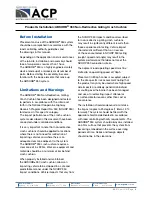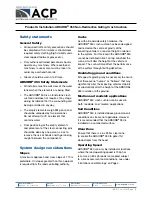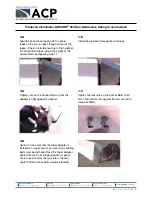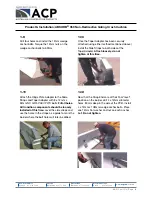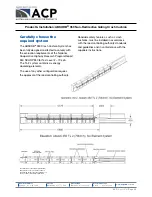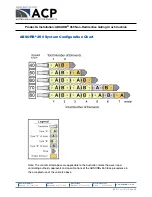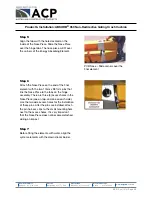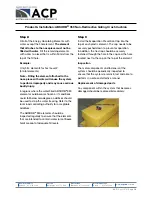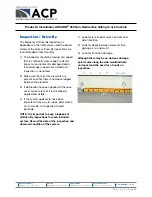
New South Wales
Sydney
02 8708 4400
Victoria
Melbourne
03 8773 5300
Queensland
Brisbane
07 3442 6200
Western Austalia
Perth
02 8708 4400
www.
acprod
.com.au
ACP
|
April 2016
|
Page
17
Product & Installation: ABSORB
®
350 Non-Redirective Gating Crash Cushion
ACP | Absorb 350
®
Crash Cushion | Mar
ch 2015
Manufacturers of Road Safety Barriers |
Australian Construction Products Pty Limited
www.
acprod
.com.au
New South Wales
Sydney
02 8708 4400
Victoria
Melbourne
03 8773 5300
Western Australia
Perth
02 8708 4400
Queensland
Brisbane
07 3442 6200
ABSORB
®
350 Crash Cushion
Location:
Installed by:
Date:
Inspected by:
Date:
Installation Checklist 70 kph or Less
Y
N
Is the road operating speed 70 kph? NOTE: If the terminal is to be used for an 80 kph
operating zone complete section B additionally.
Are the units positioned on level ground i.e. max across and approach slope of 1:10?
Is the crash cushion set out as per the design instructions in the Product and Installation
manual?
Is the vehicle impact angle, with the crash cushion, limited to 25 degrees (1 lateral: 2.14
forward)?
Ensure workers and equipment are not located in the safety or clear zone.
Are the correct number of elements for the sites peak and non-peak Operating speeds and
are they in the correct order? Refer to the System Configuration Diagram (Page 6).
Is the Transition anchored to concrete with 4 anchor bolts and to steel with 2 pins?
Are all the elements pinned together as per Installation Manual?
Have the elements been configured as per the configuration chart?
Have all elements except the final element been filled with water?
Are all elements aligned with the downstream barrier?
Has Delineation been applied to nosing as per road controlling authority requirements?
Have tools and equipment been removed from site on completion of the installation?
Is there any debris under or between the elements?
Have drive by inspections been scheduled? Minimum monthly.
Installation Checklist 80 kph
Y
N
Have all criteria in Section A of the checklist been met?
Has the risk of high speed side impact been assessed?
Has the risk of penetration behind or vaulting over the barrier been assessed?
Has the use of a re-directing impact attenuator been assessed not feasible for reasons
other than cost or convenience?
Is there a 30m clear run out area behind the barrier?
Is the application to be used at 80 kph for a short time?
Have drive by inspections been scheduled to occur more frequently?
Has the site specific risk assessment been carried out and approved by the site engineer?
Note: To be completed if ABSORB
®
350 is required to be used in 80 kph zones
SECTION A: This checklist is to be used as a guide for the safe installation of ABSORB
®
350.


